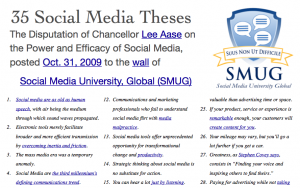The growth of social networking sites like Facebook and Twitter has been phenomenal, particularly in 2009. Facebook now boasts 350 million active users, while Twitter grew by more than 1,500 percent during 2008 – and then the growth really started to take off in 2009.
Thesis 4 would be reasonable, I think, based on these factors alone. Social media are the defining communications trend of this millennium, which is not to say they are the only important means of communication or that they have supplanted TV, radio and newspaper. (OK, well maybe newspaper.) But they embody the communications characteristic that defines our time: that anyone
But Thesis 23 says social media already are bigger than most people realize, because they don’t just include networking sites for which you need an account to participate, such as Facebook, LinkedIn, Twitter and MySpace.
YouTube is in essence a social networking site for videos, and it is the world’s second-biggest search engine after Google. So everyone who watches a YouTube video is in essence participating in social media. Those videos may even be embedded on mainstream media Web sites. But the reason we even get a chance to see them is because there is a site like YouTube which is open for anyone to upload a video at no cost. This again is how social media are defining this era.
The other reason I say everyone uses social media comes from the nature of blogs. I heard Susannah Fox of the Pew Internet Project speak at a conference in October, and she said something that validated an opinion I’ve long held. She said she expected that her organization would soon retire one of its standard survey questions because it doesn’t provide reliable information. That question asks whether respondents read blogs or not, and the affirmative percentage has held steady at about 30 percent for the last few years.
But the reality is that a blog is just an easy-to-publish Web site that allows comments. So lots of people are reading blogs as they search and surf the Web, and in most cases there isn’t a flashing icon that alerts readers that they are on a blog. I believe that anyone who spends appreciable time on the Web spends at least some time on blogs. Especially given how search engines like Google favor blogs and YouTube videos, it’s almost inconceivable that someone could do 20 Google searches without ending up on at least one site with social media elements.
So between YouTube, the most popular video source on the Web, and blogs, which are the easiest way to publish a Web site, I believe the overwhelming majority of Web users participate in some way with social media, even if it’s only as a consumer of content.
In Thesis 23 as originally posted I said:
Almost all Web surfers use social media today. They just may not know it.
For the headline of this post, and in keeping with the provocative nature of social media, I just rounded up and said “Everyone.”
I don’t think it’s much of an exaggeration. Everyone uses social media today, whether they know it or not. Even more than that, social media dramatically affect the types and amounts of content available to be consumed.
As social media grow, the proportion of time people spend on sites with social capabilities also will increase, as will the proportion of participants moving from strictly consuming content to at least commenting or rating. And many users will move from the ranks of consumers to producers, especially as the user interfaces continue to get easier.
The fact that you are reading this post means you are a social media user, at least at this moment.
Welcome to the revolution.

